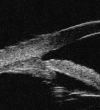The timing of goniosynechialysis in treatment of primary angle-closure glaucoma combined with cataract
- PMID: 22605920
- PMCID: PMC3351415
The timing of goniosynechialysis in treatment of primary angle-closure glaucoma combined with cataract
Abstract
Purpose: To compare the clinical effects of phacoemulsification (PHACO) combined with goniosynechialysis (GSL) at different times in the treatment of primary angle-closure glaucoma (PACG) combined with cataract.
Methods: Before surgery, one or more different kinds of anti-glaucoma medicines were used for 24 patients (32 eyes) of PACG combined with cataract. A combination of PHACO with GSL procedures were performed on both groups of patients. The patients were randomly divided into two groups: 17 patients with 21 eyes were in Group A (GSL performed before lens was removed) and 7 patients with 11 eyes in Group B (GSL after extraction of crystal cortex). Changes in visual acuity, intraocular pressure (IOP) and the depth of the center anterior chamber were observed before surgery and again at 1 month, 3 months, 6 months, and 12 months after surgery.
Results: The mean visual acuity of Group A and Group B was 1.13±0.75 and 0.93±0.50, respectively. There was no statistical difference between these two groups in visual acuity before surgery. At 1 month, 3 months, 6 months, and 12 months after surgery, the visual acuities in Group A were 0.57±0.33, 0.42±0.24, 0.30±0.23, 0.35±0.28 and the visual acuities in Group B were 0.68±0.60, 0.38±0.15, 0.40±0.17,0.33±0.13, and 0.37±0.06. Visual acuity after surgery was greatly improved in both groups. However, there was no difference between these two groups at the different points in time mentioned above. The mean IOP before surgery was 35.67±12.31 mmHg and 31.64±15.06 mmHg for Group A and Group B, respectively. At 1 month, 3 months, 6 months, and 12 months after surgery, the IOP were normalized and were significantly lower than before surgery, in group A and B. However, there was no difference in IOP between these groups at the different points in time as mentioned above. One year after surgery, the percentages of success in Group A and Group B were 86.0% and 90.0%, respectively, qualified success rates in Group A and Group B were 9.5% and 10.0%, respectively. The failure rate in Group A was 4.8%, and no one failed in Group B. In Group A, the number of medications pre-operation was 2.05±0.74. A trabeculectomy was performed on 1 eye, and anti-glaucoma medicines were used for 2 eyes after surgery to normalize IOP. In Group B, the number of medications pre-operation was 2.18±0.87. One anti-glaucoma medicine- was used for 1 eyes. In different period after surgery, anterior chamber angles in Group A were all open. Narrow anterior chamber angles in different extents also were observed in 4 eyes in Group B. The mean depth of the center anterior chamber before surgery was 1.56±0.37 mmHg and 1.72±0.35 mmHg for Group A and Group B, respectively. At 1 month, 3 months, 6 months and 12 months after surgery, the center anterior chamber was deeper than that before surgery both in both groups . However, there was no difference in the center anterior chamber's depth between these groups at the different points in time mentioned above.
Conclusions: For PACG patients with cataracts, surgery methods are shown to improve visual acuity, decrease IOP, and expand the anterior chamber angle. Regarding the opening extent of the anterior chamber angle, surgery performed on Group A achieved better results than Group B.
Figures










References
-
- Campbell DG, Vela A. Modern goniosynechialysis for the treatment of synechial angle-closure glaucoma. Ophthalmology. 1984;91:1052–60. - PubMed
-
- Tarongoy P, Ho CL, Walton DS. Angle-closure Glaucoma:The Role of the Lens in the Pathogenesis,Prevention,and Treatment. Surv Ophthalmol. 2009;54:211–25. - PubMed
-
- Chylack LT, Jr, Leske MC, McCarthy D, Khu P, Kashiwagi T, Sperduto R. Lens opacities classification system II (LOCS II). Arch Ophthalmol. 1989;107:991–7. - PubMed
MeSH terms
Substances
LinkOut - more resources
Full Text Sources
